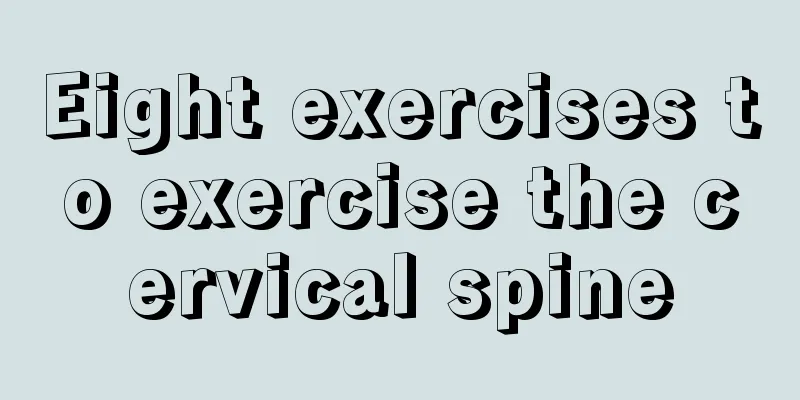Eight exercises to exercise the cervical spine

|
Nowadays, many people need to maintain a posture for a long time at work, or play with mobile phones for a long time, which may cause some damage to the cervical spine. Therefore, many people now suffer from cervical spondylosis to varying degrees. When suffering from cervical spondylosis, it will cause a lot of harm to everyone's health. Therefore, developing good habits in life and regularly exercising the cervical spine will alleviate the damage to the spine. 1. Vajra Pose Action: Kneel on the floor, place your hands on your thighs, and inhale. Exhale and slowly lean your body backward until the top of your head gradually touches the ground, and put your hands together in front of your chest. Function: Stretches the muscles of the spine, neck and back. 2. Fish pose Action: Lie flat on your back, arch your body while inhaling, support your body with your head and hips, and form a hole in your back; curl and cross your knees, put your palms together above your head or cross your arms and hold your elbows. As you exhale, slowly relax your body and lie flat on your back. Effect: This movement can place the stress and extension points on the cervical spine. It is also helpful for the health of the lumbar spine and can eliminate wrinkles on the neck. Beginners can stretch their legs straight, which greatly reduces the difficulty and makes the training goal clearer. 3. Cat Stretch Action: Kneel on the floor and support your body with your hands. Inhale, stretch your spine downward, lift your head and neck upward, and lift your hips up. Exhale, tuck your chest in, arch your back, lower your head and neck downward, tighten your abdominal muscles, and arch your entire back as much as possible. Function: Make the spine and surrounding muscle groups more elastic, relax the neck and shoulders, and make the back muscles work in a coordinated manner. 4. Wolf Stretch Action: Support your body with your hands and toes, stretch your legs as much as possible, tilt your head back when inhaling to fully stretch the front of your neck, and keep your arms perpendicular to the ground. When exhaling, slowly relax your head and return to its normal position. Function: This posture can fully stretch the 26 spinal cord segments, stimulate the connection between the brain and spinal cord, and is very helpful for nourishing the brain. 5. Ostrich pose Action: Spread your legs shoulder-width apart, bend over, and place your hands under the soles of your feet, with your palms touching them. Raise your head when you inhale, and slowly relax when you exhale. Function: This pose can improve cervical fatigue and can be done together with the pug pose. 6. Cow Face Pose Action: Sit on the floor, cross your legs, keep your knees in a straight line, and place your feet next to your hips on opposite sides. Clasp your hands behind your back, keeping your back straight. If this is difficult, you can grab a towel with both hands to achieve the same effect. Function: Correct the cervical vertebrae and spine, expand the chest, relax the shoulder joints, and stretch the latissimus dorsi muscles. 7. Turtle pose Movement: The two movements of breathing are like a turtle poking its head out of its shell. Open your knees, sit up straight, and curl your calves back to the base of your thighs; lean forward, open your palms, and when you inhale, move your cervical spine and lift your chin. When you exhale, bring your chin closer to your chest, focusing the movement on your neck. Function: The Tortoise Pose mainly exercises the flexibility of the cervical spine. It is also very helpful for shaping the neck line and eliminating double chins. 8. Pug pose Action: Stretch your legs straight and spread them as far apart as possible, bend your upper body down, support yourself with your hands, and keep your back stretched. When inhaling, stretch your arms vertically and lift your head up. When exhaling, use the top of your head, elbows and feet as gravity support points to keep your waist and back stretched. If you find the exercise too difficult, bend your legs slightly to reduce the pressure on your ligaments. Function: stretch the waist and back. |
<<: Will cervical ligament calcification heal itself?
>>: Can I wear henna while pregnant?
Recommend
What are the methods to fight eye fatigue?
Many white-collar workers face the computer for a...
How to treat ascites in advanced liver cancer
Ascites treatment is actually a treatment method ...
Can patients with rectal cancer exercise?
Although the incidence of rectal cancer is gettin...
Differential diagnosis of anorectal cancer
Anorectal cancer is a malignant tumor that occurs...
What diseases cause arthritis
Arthritis is a relatively common disease. There a...
How should gallstones with acute cholecystitis be treated?
If a patient with gallstones also has acute chole...
Can early liver cancer be cured? Can it be cured?
Timely treatment of early liver cancer can achiev...
How can a tall and thin person gain weight?
I feel that the world is always unfair. There are...
Is it better to use BB cream or liquid foundation?
The method of using liquid foundation is very sim...
What are the effects and functions of fat emulsion
Fat emulsion is a drug that can supplement energy...
Can I eat oranges while taking anti-inflammatory medicine?
Sometimes drugs will react incompatiblely with fo...
Complete Detox Tea Recipe
If you want to be healthy and more beautiful, it ...
What are the typical symptoms of early lung cancer? There are 4 typical symptoms of early lung cancer
Some patients have experienced this situation, th...
Is it good to eat a banana before going to bed? The truth is this
Is it good to eat a banana before going to bed? T...
Can I use enema if I have hemorrhoids?
When constipated, many people will use some help ...









